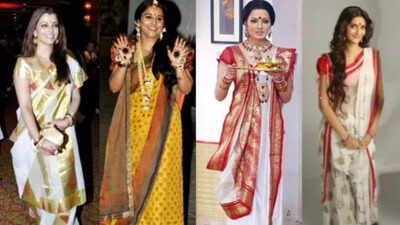There’s a special kind of alchemy in a saree. Six to nine yards of fabric transform, through a few deft tucks and pleats, into something graceful, practical, and wildly individual. Across India, communities have evolved distinctive drapes to suit climate, work, ritual, and aesthetics. Below are six of the most loved, widely recognized saree-tying styles, each with a quick primer on how it’s worn and what makes it beloved.
Nivi (Andhra–Telugu classic)
If you imagine a “typical” saree, you’re likely picturing the Nivi: pleats fall neatly in front, and the pallu comes over the left shoulder. It’s popular because it’s adaptable, elegant for ceremonies, effortless for everyday wear, and friendly to most fabrics from cotton to silk. Historically associated with Andhra Pradesh/Telangana, the Nivi is now pan-Indian and the foundation many learners start with.
Bengali Aatpoure

Credits: Thor AV
The Aatpoure drape has a soft, statuesque flow. You begin tucking at the right side, make generous pleats in front, and bring the pallu over the left shoulder, often looping it back or allowing it to fall long and loose. In traditional looks, women sometimes accessorize the end of the pallu; modern stylists keep the signature ease of those wider, relaxed pleats.
Gujarati Seedha Pallu
“Seedha pallu” literally brings the pallu to the front: the fabric comes from the back and settles over the right shoulder, showcasing borders, brocades, or embroidery on the torso. This drape is common in Gujarat and seen across North and West India for festive wear because it spotlights the saree’s most ornate work.
Maharashtrian Nauvari (Kaashtha/Kasta)
Worn with a nine-yard saree, the Nauvari (literally “nine yards”) passes a length of fabric between the legs and tucks it at the back, creating a dhoti-like ease that’s great for movement. You’ll see it at traditional functions, lavani performances, and festivals; it’s both practical and regal, often paired with Paithani silks and a nath.
Tamil Madisar (Iyer/Iyengar)
Another nine-yard icon, the Madisar blends a dhoti-like lower with a saree upper. Worn historically by Tamil Brahmin women, especially for weddings and religious ceremonies, it has two noted sub-styles (Iyer and Iyengar) and is traditionally paired with a special “koorai” silk. The look is architectural and auspicious, with deep ritual meaning.
Coorgi/Kodagu Style (Karnataka)
Distinct at first glance, the pleats face backwards and the pallu is pinned on the right shoulder. Oral histories and community practice point to a drape evolved for hilly terrain and active daily life in Kodagu. The effect is crisp, secure, and unmistakably regional.










